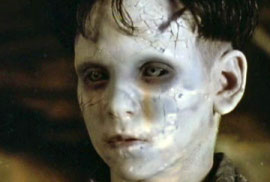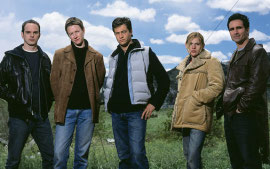 MEN IN BLACK II
MEN IN BLACK II
I'm not sure how much there is to say about Men in Black II, director Barry Sonnenfeld's sequel to his sci-fi/comedy smash. There's always something to look at, Will Smith and Tommy Lee Jones provide the occasional flash of dry wit, and it's all over blessedly fast - the movie runs some 85 minutes with end credits, and you wouldn't want it to last a minute longer.
The movie should be the very definition of lightweight summertime entertainment, yet I can't be alone in thinking that it suffers from a shocking lack of inspiration and that it's redundant as hell. Men in Black II provides what the 1997 film did minus the originality; unfortunately, that originality was about the only thing that made MIB memorable in the first place. It appears, to me, the most cynical of sequels - give the audience exactly what they loved the first time around, and nothing more. If you clone it, they will come.
Men in Black II is oftentimes this close to clever without ever really getting there. Icy-cool Lara Flynn Boyle plays a tentacled slimeball in Victoria's Secret lingerie, Johnny Knoxville shows up as a dipstick with two squabbling heads, Rip Torn returns as the MIB's commander and displays a surprising knack for Matrix-style martial-arts moves - and not one of these gags is as funny onscreen as it is on paper. Because the film's plotting is typically unimportant, all we're left with are lengthy carbon copies of the original's jokes. This time, it's Smith who teaches Jones the MIB drill (Jones' memories having been erased in the original film's finale), the cigarette-smoking worms who were constantly on a coffee break become accomplices in the action, and Tony Shalhoub's arms-dealing alien again gets his head blown off and it grows back - twice. The only old gag that still seems fresh is the film's talking pug, and even then it's only a giggle when the yipping canine "sings" along to the hip-hop number "Who Let the Dogs Out?" Rick Baker's makeup design is, unsurprisingly, first-rate, but everyone else involved with Men in Black II seems merely to be going through the motions. Five years, an eternity in sequel terms, have passed since the first Men in Black debuted, and even though this follow-up is easy enough to sit through, it feels ungainly and undernourished. It's stale popcorn.
 THE DEVIL'S BACKBONE
THE DEVIL'S BACKBONE
Of considerably greater interest are two titles new to video and DVD: Guillermo del Toro's The Devil's Backbone and Moises Kaufman's The Laramie Project. Del Toro's work, presented in Spanish with English subtitles, is a fascinating hybrid: the political drama-cum-horror movie. Set in a dilapidated boarding school at the end of the Spanish Civil War, a newly orphaned youth named Carlos (Fernando Tielve) has to survive poverty, the bullying of other children, the random cruelties of a steely-eyed handyman (Eduardo Noriega), and, oh yes, the restless spirit of a child killed the night an unexploded bomb landed in the schoolyard. In story terms, The Devil's Backbone often resembles a paranormal Oliver Twist, and it's a little heavy with its political metaphors: that defused bomb, the literal impotence of the children's chief caretaker, the repeated voice-over of what constitutes an actual "ghost." But del Toro's direction transcends the banality of some of the film's ideas. He shows a true gift for poetically disturbing imagery - the young ghost, who was drowned after a massive head injury, walks about with his wound still bleeding, the blood rising up, as if toward the surface - and he elicits amazing work from his young cast, Mr. Tielve in particular. The film itself is beautifully shot throughout and puts the viewer under a unique spell; despite its realistic, historical setting, it doesn't feel the least bit odd that a ghost would interact with the living - the boarding school itself feels ghostlike, and the spirit that resides there becomes an extension of the pain and grief its walls have seen. The Devil's Backbone doesn't offer much in the way of "traditional" scares, but like Alejandro Amenabar's The Others from last summer, it's a creepy, impressive effort, and it deserves to find an audience.
 THE LARAMIE PROJECT
THE LARAMIE PROJECT
In many ways, The Laramie Project, which made its debut on HBO this spring, is an even stranger piece, though no less riveting. Based on a play by Kaufman and the members of the Tectonic Theater Project, the film explores the aftermath of the Matthew Shepard killing, as seen through the eyes of the townspeople of Laramie, Wyoming, where the brutal crime took place. Roughly 95 percent of the film's dialogue is actual, transcribed conversation between the playwrights and the citizens of Laramie, yet it's delivered here by a slew of stars and familiar character actors, which is what makes this work so unusual, and sometimes so frustrating. It's often said that the hardest thing for an actor to do is play real, and The Laramie Project proves to be a case study for that thesis. Because these are the words of real people, speaking spontaneously in interview style, the dialogue doesn't have the professional sheen of what we normally associate with "movie dialogue"; the interviewees, aiming for eloquence, use words and phrases inappropriately, stutter and repeat themselves, and, like most people, find it nearly impossible to verbalize the intensity of their feelings. In documentary format, this can be heart-wrenching. As a mock-documentary, it's mesmerizing to see which actors can and can't make this style believable.
In a cast with fifty-odd speaking roles, all the actors are earnest (as in HBO's AIDS drama And the Band Played On, their passion for the project clearly took precedence over the size of their roles), but a few of them - Christina Ricci, Laura Linney, Peter Fonda, Kathleen Chalfant, Camryn Manheim, Frances Sternhagen - struggle a bit too hard with their "just folks" characterizations; their dialogue sounds tinny coming from their professionally trained voices, and an unpleasant air of phoniness seeps into their performances. Yet their well-intended, essentially fraudulent work is outweighed by an even greater number of performers who get the style just right - especially Steve Buscemi, Amy Madigan, Janeane Garofalo, Joshua Jackson, Clancy Brown, Clea Duvall, Jeremy Davies, Ben Foster, and Terry Kinney - and by the tragic, horrific nature of the Matthew Shepard tale itself, which gradually becomes an indictment of the terrifying indifference many had toward this particular hate crime. When, in the film, one Laramie citizen calls Shepard's torture and murder "partially his [Matthew's] fault and partially the guys who did it" and assigns the blame with "maybe it's 50-50," it's as clear an example of Midwestern bigotry as you're likely to hear, and it makes The Laramie Project, for all its unorthodox trappings, absolutely essential viewing.








